Increased Imports of Colorants and Constituent Components during the 18th Century Reflects the Start of the Consumer Society in Norway
Abstract
:1. Introduction
2. Materials and Methods
3. Results
3.1. Pigments, Binders and Other Additives
3.2. Dyes, Mordants and Auxilliaries
3.3. Prices
3.4. Imports of other Consumer Goods
3.5. Export and Domestic Trade in the 18th Century and Imports in 1835
3.6. Two Periods of Increased Colorant Imports
3.7. Imports by Color
4. Discussion
4.1. Colorants as Consumer Goods
4.2. Two Chromatic Revolutions
4.3. Domestic Market
4.4. Increased Use
4.4.1. Increased Use of Imported Pigments
4.4.2. Increased Use of Imported Dyes
4.5. Increased Demand
4.5.1. Preferential Use
4.5.2. Fashionability and Consumer Culture
4.5.3. Economy
4.5.4. Enlightenment
4.6. Colorant Imports and the Start of the Consumer Society
5. Conclusions
Funding
Data Availability Statement
Acknowledgments
Conflicts of Interest
Appendix A
| Year | Author | Descriptions and Theories |
|---|---|---|
| 1714 | Bernard Mandeville [56] | Humans are self-absorbed, pleasure-seeking and vain, who sought luxury to fulfill these needs. |
| 1776 | Adam Smith [68] | Consumption was the sole purpose of all production. |
| 1899 | Thorstein Veblen [69] | Conspicuous consumption and pecuniary emulation. |
| 1904 | Georg Simmel [70] | Trickledown effect, mutual influence between social layers. |
| 1932 | ElizabethGilboy [71] | Supply and demand were equal driving forces. |
| 1972 | Franklin Mendels [72] | Proto-industrialization. |
| 1977 | Joel Mokyr [73] | Industrialization was mostly supply-driven. Increased demand requires increased income, falling prices or a change in preferences. |
| 1982 | Neil McKendrick [1] | Consumer revolution. Importance of emulation. |
| 1988 | Lorna Weatherill [5] | Consumption was promoted as part of a separate middle-class culture, semi-luxury goods. |
| 1990 | Carol Shammas [74] | Changes in households with increased demand. |
| 1991 | Maxine Berg [75] | Globalization and increased consumption of luxury products, cheaper products. |
| 1991 | Beverly Lemire [76] | Fashion was a driving force for the demand and distribution of cotton clothing, spread vertically and horizontally. |
| 1993 | Cissy Fairchilds [77] | Nation of shoppers, Dress fashion, populuxe goods. |
| 1994 | John Brewer [78] | The importance of demand and consumption. |
| 1994 | Jan de Vries [61] | Industrious revolution. |
| 2006 | Jonathan White [79] | Access to new goods in the 18th century led to increased consumption. |
| 2009 | Joel Mokyr [80] | Importance of enlightenment. |
| 2011 | Rene Girard [81] | Mimetic desire. |
| 2016 | Joel Mokyr [82] | Importance of consumer culture. |
Appendix B
| Name | Product | First Import (year) | Price (daler/ pound) | Quantity Imported during the 18th Century (pound) | Quantity Imported 1685 and/or 1686 (pound) |
|---|---|---|---|---|---|
| Alum | Mordant for dyeing | 1685 | 0.09 | 140,438 | 2,410 |
| Amber | Additive (resin for painting) | 1740 | |||
| Annatto (orleans and uldrian) | Yellow dye | 1724 | 0.38 | 4,637 | |
| Asphalt | Brown pigment | 1756 | |||
| Berberis roots | Yellow dye | 1835 | |||
| Bitgelrødt | Red pigment | 1733 | |||
| Bole | Red pigment | 1732 | |||
| Bone black | Black pigment | 1835 | |||
| Bone brown | Brown pigment | 1749 | |||
| Brazilwood | Red dye and pigment | 1686 | 0.07 | 131,808 | 247 |
| Brazilwood, rasped | Red dye and pigment | 1724 | 0.03 | 68,664 | |
| Brown red | Red pigment | 1685 | 0.02 | 109,223 | 80 |
| Brunswick green | Green pigment | 1835 | |||
| Burnt Sienna | Brown pigment | 1756 | |||
| Caput mortuum | Reddish purple pigment | 1749 | 0.1 | 4,993 | |
| Carbon black | Black pigment | 1751 | 0.63 | 3,583 | |
| Chalk, red chalk | Red pigment | 1686 | 0.19 | 2,060 | 17 |
| Chrome yellow | Yellow pigment | 1835 | |||
| Ciginie red | Red pigment | 1794 | |||
| Cochineal | Red dye and pigment | 1724 | 4.67 | 4,242 | |
| Cologne earth | Brown pigment | 1756 | |||
| Colophony | Additive (varnish for painting) | 1731 | |||
| Copper(II)sulphate (blåstein) | Additive (siccative for painting) and auxillary agent for dyeing | 1762 | 0.18 | 609 | |
| Copper(II)sulphate (kobberrøg) | Additive (siccative for painting) and auxillary agent for dyeing | 1756 | 0.22 | 331 | |
| Cream of Tartar | Auxiliary agent for dyeing | 1685 | 0.1 | 37,952 | 1,063 |
| Danish red | Red pigment | 1754 | Domestic | ||
| Dyer’s buckthorn | Yellow pigment and dye | 1724 | 0.41 | 2,894 | |
| Earth pigment | Red pigment | 1730 | 0.05 | 3,904 | |
| English earth | Red pigment | 1732 | 0.05 | 11,813 | |
| Florentine lake | Red pigment | 1742 | 2 | 12 | |
| Gallnut | Black dye and mordant | 1686 | 0.27 | 5,322 | 69 |
| Glue | Binder for painting | 1686 | 0.07 | 11,906 | 736 |
| Graphite | Black pigment | 1725 | 0.1 | 2,198 | |
| Gum | Additive (dyeing and painting) | 1685 | 0.4 | 4,142 | 38 |
| Gum arabic | Additive (dyeing and painting) | 1770 | |||
| Gum copal | Additive (dyeing and painting) | 1835 | |||
| Gum elemh | Additive (dyeing and painting) | 1835 | |||
| Gum from Burseraceae | Additive (dyeing and painting) | 1724 | |||
| Gum tragacanth | Additive (dyeing and painting) | 1749 | |||
| Gum, ordinary | Additive (dyeing and painting) | 1770 | 0.27 | 2,063 | |
| Horn glue | Binder for painting | 1685 | 0.1 | 10,815 | 490 |
| Indigo | Blue dye and pigment | 1686 | 1.6 | 68,762 | 12 |
| Ink powder | Black pigment | 1724 | 0.26 | 1,311 | |
| Isinglass | Binder for painting | 1726 | 1.43 | 432 | |
| King’s yellow (kongegult) | Yellow pigment | 1752 | 0.56 | 292 | |
| Lake pigment (kulelakk) | Red pigment | 1725 | 0.59 | 645 | |
| Lake pigment (kurlakk) | Red pigment | 1724 | 0.44 | 115 | |
| Lakk | Additive (varnish for painting) | 1685 | 1.02 | 4,030 | 53 |
| Lead white | White pigment | 1685 | 0.07 | 337,661 | 80 |
| Lead white (skiferhvitt) | White pigment | 1733 | 0.19 | 77 | |
| Lichen | Dye, different colors | 1786 | |||
| Lichen, black | Dye, different colors | 1835 | |||
| Lichen, color lichen | Dye, different colors | 1835 | |||
| Lichen, Island lichen | Dye, different colors | 1786 | |||
| Lichen, mountain lichen | Dye, different colors | 1794 | |||
| Lichen, stone lichen | Dye, different colors | 1835 | |||
| Lichen, white | Dye, different colors | 1794 | |||
| Linseed oil | Binder for painting | 1685 | 0.16 | 217,416 | 6,606 |
| Litharge of silver | Additive (siccative for painting) | 1686 | 0.12 | 9,645 | 24 |
| Litmus | Blue dye and pigment | 1749 | 0.17 | 585 | |
| Logwood (blauholt) | Dye, different colors | 1749 | 0.06 | 2,111 | |
| Logwood (brissel) | Dye, different colors | 1685 | 0.04 | 7,194 | 610 |
| Logwood (brown brissel) | Dye, different colors | 1733 | 0.08 | 1,105 | |
| Logwood (campecheholt) | Dye, different colors | 1732 | 3,989 | ||
| Logwood, red | Red dye and pigment | 1733 | |||
| Madder | Red dye and pigment | 1686 | 0.16 | 59,920 | 30 |
| Mastic | Additive (varnish for painting) | 1725 | 43 | ||
| Mineral blue | Blue pigment | 1835 | |||
| Mineral green | Green pigment | 1749 | |||
| Mineral yellow | Yellow pigment | 1835 | |||
| Minium, red lead | Red pigment | 1685 | 0.07 | 60,485 | 424 |
| Montain blue | Blue pigment | 1762 | |||
| Naples yellow | Yellow pigment | 1749 | |||
| Ochre, brown | Brown pigment | 1733 | |||
| Ochre, yellow | Yellow pigment | 1685 | 0.05 | 48,543 | 170 |
| Old fustic or dyer’s mulberry | Yellow dye | 1774 | |||
| Orpiment (orpiment and rusgel) | Yellow pigment | 1686 | 0.18 | 2,197 | 51 |
| Paris green | Green pigment | 1835 | |||
| Parrot green | Green pigment | 1835 | |||
| Peach-stone black | Black pigment | 1835 | |||
| Pernambuco wood | Red dye, Brazilwood | 1724 | 0.15 | 26,896 | |
| Potash | Mordant for dyeing | 1762 | 0.18 | 766,431 | |
| Prussian blue | Blue pigment | 1733 | 1.51 | 1,537 | |
| Quercitron | Yellow dye | 1835 | |||
| Reseda luteola, weld, (vav) | Yellow dye | 1732 | |||
| Resin | Additive (resin for painting) | 1686 | 0.05 | 35,602 | 852 |
| Rye oil | Binder for painting | 1754 | |||
| Safflower | Red/Yellow dye | 1756 | |||
| Saffron | Yellow pigment | 1685 | 8.61 | 895 | 12 |
| Sandalwood | Red dye and pigment | 1732 | 0.08 | 6,989 | |
| Sandarac | Additive (dyeing and painting) | 1742 | |||
| Sappanwood | Red dye | 1835 | |||
| Saw-wort | Yellow dye | 1726 | 0.04 | 5,894 | |
| Shellac | Additive (varnish for painting, polishing agent) | 1749 | 0.26 | 1,189 | |
| Sky blue | Blue pigment | 1685 | |||
| Smalt (blausel ) | Blue pigment | 1685 | 0.15 | 19,522 | 130 |
| Smalt (oljeblått) | Blue pigment | 1749 | |||
| Smalt blue | Blue pigment | 1762 | |||
| Spike oil | Additive (diluent for painting) | 1727 | |||
| Sumac | Brown dye | 1731 | 0.1 | 378,379 | |
| Tar | Black pigment | 1685 | |||
| Turmeric | Yellow dye and pigment | 1724 | 0.25 | 1,890 | |
| Turpentine | Additive (diluent for painting) | 1685 | 0.14 | 16,589 | 100 |
| Turpentine, oil | Additive (diluent for painting) | 1732 | 0.15 | 16,913 | |
| Turpentine, venetian | Additive (resin for painting) | 1762 | |||
| Ultramarine | Blue pigment | 1835 | |||
| Umber | Brown pigment | 1686 | 0.13 | 1,038 | 36 |
| Varnish | Additive (varnish for painting) | 1733 | |||
| Verdigris | Green dye and pigment | 1686 | 0.6 | 5,741 | 12 |
| Vermilion | Red pigment | 1686 | 1.22 | 1,410 | 22 |
| Vitriol | Auxiliary agent for dyeing | 1685 | 0.03 | 101,615 | 170 |
| Vitriol, anglicum | Auxiliary agent for dyeing | 1751 | 7,571 | ||
| Vitriol, blue | Auxiliary agent for dyeing and additive (siccative for painting) | 1835 | |||
| Vitriol, green | Auxiliary agent for dyeing | 1835 | |||
| Vitriol, IronI(II)sulfate | Auxiliary agent for dyeing | 1749 | 0.13 | 39,629 | |
| Vitriol, white | Auxiliary agent for dyeing | 1835 | |||
| Woad | Blue dye | 1724 | |||
| Yellow pigment (blekgult) | Yellow pigment | 1762 |
References
- McKendrick, N.; Brewer, J.; Plumb, J.H. The Birth of a Consumer Society: The Commercialization of Eighteenth-Century England; Indiana University Press: Bloomington, IN, USA, 1982. [Google Scholar]
- Sassatelli, R. Consumer Culture: History, Theory and Politics; SAGE Publications Ltd.: London, UK, 2007. [Google Scholar]
- Berg, M. The Age of Manufactures 1700–1820. Industry, Innovation and Work in Britain; Routledge: London, UK, 2005. [Google Scholar]
- Roach, B.; Goodwin, N.; Nelson, J. Consumption and the Consumer Society; Tufts University, Somerville Campus: Medford, MA, USA, 2019. [Google Scholar]
- Weatherill, L. Consumer Behavior and Material Culture in Britain, 1660–1760; Routledge: London, UK, 1988. [Google Scholar]
- Walton, P. Dyes of the Viking Age: A summary of recent work. Dyes Hist. Archaeol. 1988, 7, 14–20. [Google Scholar]
- Nordeide, S.W. Den gylne middelalder. Spor–Fortidsnytt Fra Midt-Nor. 1991, 1, 19–21. [Google Scholar]
- Plahter, U. Painted Altar Frontals of Norway 1250–1350, Illustations and Drawings; Archetype Publications: London, UK, 2004; Volume 3. [Google Scholar]
- Knudtzon, M.A. Økt Import og Bruk av Indigo på 1700-Tallet, Fire Indigoperioder Satt i en Forbrukerhistorisk Kontekst. Master’s Thesis, Universitetet i Oslo, Oslo, Norway, 2020. [Google Scholar]
- Knudtzon, M.A. Økt Fargeimport og Fremveksten av Forbrukersamfunnet i Norge. To Kromatiske “Revolusjoner’’ og 1700-Tallets Forbrukerhamskifte. Ph.D. Thesis, University of Oslo, Oslo, Norway, 2023. to be submitted. [Google Scholar]
- Forside: Historiske toll- og Skipsanløpslister. Available online: https://lokalhistoriewiki.no/wiki/Forside:Historiske_toll-_og_skipsanl%C3%B8pslister (accessed on 18 September 2022).
- Transkriberte Historisk Norske Tollister, Alle Varer. Available online: https://tidvis.no/historiske_databaser/varelister/ (accessed on 18 September 2022).
- Teige, O. Det Store Tollsviket og Inkvisisjonskommisjonen i Christiania 1705–09; Hovedoppgave; Universitetet i Oslo: Oslo, Norway, 2001. [Google Scholar]
- Jørgensen, H.J. Det Norske Tollvesens Historie. Fra Middelalderen til 1814; Tolldirektoratet: Oslo, Norway, 1969.
- Holmsen, A. Den økonomiske bakgrunnen for Kristiania-patrisiatet. In Studier i Norsk Historie 1537-ca. 1800; Imsen, S., Supphellen, S., Kjelland, A., Eds.; Universitetsforlaget: Oslo, Norway, 1983; pp. 334–335. [Google Scholar]
- Røgeberg, K.M. Norge i 1743,Innberetninger Som Svar på 43 Spørsmål fra Danske Kanselli, Akershus Stift og Amt, Østfold og Akershus; Bind 1; Solum Forlag: Oslo, Norway, 2003. [Google Scholar]
- Røgeberg, K.M. Norge i 1743,Innberetninger Som Svar på 43 Spørsmål fra Danske Kanselli, Akershus Stift, Hedemark, Oppland; Bind 2; Solum Forlag: Oslo, Norway, 2004. [Google Scholar]
- Røgeberg, K.M. Norge i 1743,Innberetninger Som Svar på 43 spørsmål fra Danske Kanselli, Akershus Stiftamt, Buskerud, Vestfold, Telemark; Bind 3; Solum Forlag: Oslo, Norway, 2005. [Google Scholar]
- Løyland, M. Norge i 1743, Innberetninger Som Svar på 43 Spørsmål fra Danske Kanselli, Aust-Agder, Vest-Agder, Rogaland, Hordaland, Sogn og Fjordane; Bind 4; Solum Forlag: Oslo, Norway, 2006. [Google Scholar]
- Mordt, G. Norge i 1743,Innberetninger Som Svar på 43 Spørsmål fra Danske Kanselli, Møre og Romsdal, Sør-Trøndelag, Nord-Trøndelag, Nordland, Troms; Bind 5; Solum Forlag: Oslo, Norway, 2008. [Google Scholar]
- Store Norske Leksikon. Fat. Available online: https://snl.no/fat_-_eldre_norsk_m%C3%A5l (accessed on 21 June 2021).
- Olstad, T.M. Bryggens farger. Fortidsminneforen. Årbok 2006, 160, 67–73. [Google Scholar]
- Sellæg, J. Drammen By i Utvikling Gjennom 400 år; Brakar AS: Drammen, Norway, 2010. [Google Scholar]
- Johansen, T.A. Trangen til Læsning stiger, selv oppe i ultima Thule. Aviser, ekspansjon og teknologisk endring ca 1763–1880. Pressehistoriske Skr. 2006, 7, 33. [Google Scholar]
- Smesrud, I. Sluttrapport Plantefarging av lin og Hamp. Inspirert av Susanna Johanna Pihl, 22–23. Available online: https://handverksinstituttet.no/prosjekter/rapport-om-plantefarging-av-lin-og-hamp (accessed on 11 March 2022).
- Berg, M. Consumption in eighteenth- and early nineteenth-century Britain. In The Cambridge Economic History of Modern Britain. Volume 1: Industrialisation, 1700–1860; Floud, R., Johnson, P., Eds.; Cambridge University Press: Cambridge, UK, 2004; pp. 357–387. [Google Scholar]
- Hutchison, R. Det norske kobberet i Europa og verden på 1700-tallet. In Skandinavisk Kobber: Lokale Forhold og Globale Sammenhenger i Det Lange 1700-Tallet; Ranestad, K., Bruland, K., Eds.; Cappelen Damm Akademisk: Oslo, Norway, 2020; pp. 111–127. [Google Scholar]
- Grist, K. Dangerous Beauty: Hazardous Chemicals and Poisons in Historic Cosmetics. Available online: https://www.sciencemuseumgroup.org.uk/blog/dangerous-beauty-hazardous-chemicals-and-poisons-in-historic-cosmetics/ (accessed on 12 November 2022).
- Müller, L. Kolonialprodukter i Sveriges handel och konsumtionskultur, 1700–1800. Hist. Tidsskr. 2004, 124, 225–248. [Google Scholar]
- Odile-Bernez, M. Comfort, the Acceptable Face of Luxury: An Eighteenth-Century Cultural Etymology. J. Early Mod. Cult. Stud. 2014, 14, 3–21. [Google Scholar] [CrossRef]
- Berg, M. Luxury and Pleasure in the Eighteenth-Century Britain; Oxford University Press: Oxford, UK, 2005. [Google Scholar]
- Brænne, J. Dekorasjonsmaling. Marmorering, Ådring, Lasering, Patinering, Sjablondekor, Strukturmaling; Teknologisk Forlag: Oslo, Norway, 1998. [Google Scholar]
- Ellingsgard, N. Norsk Rosemåling. Dekorativ Måling i Folkekunsten; Det Norske Samlaget: Oslo, Norway, 1999. [Google Scholar]
- Engelstad, H. Plantefarvingens historie i Norge. In Norsk Billedvev 1550–1800; Kielland, T.B., Ed.; Gyldendals Forlag: Oslo, Norway, 1953; Volume I. [Google Scholar]
- Sverdrup, S. Using Plants for Dyeing in Norway. Handb. Dyes Plants Dye. 1964, 20, 66–69. [Google Scholar]
- Bull, I. Lokalsamfunnet i Verden, Norske Lokalsamfunns Plass i den Første Globaliseringen på 1600- til 1800-Tallet; Novus forlag: Oslo, Norway, 2020. [Google Scholar]
- Margairaz, D. City and Country: Home, Possessions, and Diet, Western Europe 1600–1800. In The History of Consumption; Trentmann, F., Ed.; University Press: Oxford, UK, 2012; pp. 194–210. [Google Scholar]
- Hutchison, R. Toll-Lister og 1700-Tallet: Skal det Være en Kopp Kaffe? Available online: https://blogg.forskning.no/ragnhild-hutchisons-blogg/toll-lister-og-1700-tallet-skal-det-vaere-en-kopp-kaffe/1100548 (accessed on 6 September 2021).
- Hagset, M. Kaffeimport til Norge, 1733–1794. Bachelor’s Thesis, Universitetet i Oslo, Oslo, Norway, 2016. [Google Scholar]
- Hutchison, R. In the Doorway to Development. An Enquiry into Market Oriented Structural Changes in Norway ca. 1750–1830. Ph.D. Thesis, Brill, Leiden, The Netherlands, 2012. [Google Scholar]
- Drange, T.; Aanensen, H.O.; Brænne, J. Gamle Trehus; Universitetsforlaget: Oslo, Norway, 1994. [Google Scholar]
- Valderaune, M.O. Praktisk Fargesetting av Historiske Interiør en Fortelling, en Introduksjon, et Verktøy. Diploma Thesis, Universitet i Trondheim, Trondheim, Norway, 2015. [Google Scholar]
- Anonymous. Nye- og Fuldstændig Maler- og Forgylder-Bog; B.M. Liunges Forlag: København, Denmark, 1794. [Google Scholar]
- Kvaal, I.M. Klededrakt på Romeriksbygdene ca 1600–1850; Akershus Trykkeri: Lillestrøm, Norway, 1942. [Google Scholar]
- Dahl, C.L. Klædt i Rigets Borgerdragt. Stand, Status og National Identitet Udtrykt i Borgerskabets Dragt i Reformationstidens Danmark-Norge og Sverige; Norsk Folkemuseum: Oslo, Norway, 2015. [Google Scholar]
- Røgeberg, K.M. Av saliges gangklær, Klær og klesskikk i og rundt Kristiania omkring år 1700. Arkivmagasinet 2008, 3, 15–17. [Google Scholar]
- Røgeberg, K.M. Av Saliges Gangklær, en Skifteanalyse, Aker Fogderi og Christiania 1656–1780. Ph.D. Thesis, Universitetet i Oslo, Oslo, Norway, 1989. [Google Scholar]
- Hutchison, R. Fargeeksplosjonen på 1700-Tallet. Norgeshistorie. Available online: https://www.norgeshistorie.no/enevelde/1243-fargeeksplosjonen-pa-1700-tallet.html (accessed on 18 September 2022).
- En Dansk Farve-Bog til Almindelig Nytte eller Kort Underretning om at farve Ulden, Silke og Linned, tilligemed Opskrift paa Nogle Slags Blæk, saa og om at aftage alle Slags Plætter paa Tøy; I.F. Heineck Mumme og Faber: København, Denmark, 1768.
- Fuldstændig Fruentimmer-Farve-Bog, Eller Tydelig Underviisning om Farve-Kunsten, Hvorledes Man Kan Farve Alle Slags Uldent, Linnet, Silke og Bomulds-Tøy og Garn etc., Samlet og Uddraget af Hellots, Lindners og Andres Trykte Underretninger og Skrevne Opskrifter, Saavel til Tieneste for Farvere Som og Især for Fruentimmer paa Landet, Tilligemed en Tilføyet Plette- og Kunst-bog, Samt om Læder- og Skind-Farvingen; A. H. Godiche: København, Denmark, 1768.
- Tangen, H.A.P. En Svartebok; 1779. A-100027-Dokumentsamlingen-Statsarkivet i Bergen. https://www.arkivportalen.no/entity/no-a1450-07000000099760, Not available online.
- Engel, A. Colouring markets: The industrial transformation of the dyestuff business revisited. Bus. Hist. 2012, 54, 10–29. [Google Scholar] [CrossRef]
- Leksikon: Veksel. Available online: https://lokalhistoriewiki.no/wiki/Leksikon:Veksel (accessed on 18 September 2022).
- Nash, R.C. South Carolina indigo, European textiles, and the British Atlantic economy in the eighteenth century. Econ. Hist. Rev. New Ser. 2010, 63, 362–392. [Google Scholar] [CrossRef]
- Kirby, J. Painting in a wider world: Developments in the trade in painters’ material. In Trading Paintings and Painters’ Materials 1550–1800; Christensen, A.H., Jager, A., Eds.; CATS Proceedings, IV; Archetype Publications Ltd.: Copenhagen, Denmark, 2018. [Google Scholar]
- Mandeville, B. Fable of the Bees; Clarendon Press: London, UK, 1724. [Google Scholar]
- Parthasarathi, P.; Riello, G. From India to the World: Cotton and fashionability. In The History of Consumption, Trentmann, F. Ed.; University Press: Oxford, UK, 2012; pp. 144–170. [Google Scholar]
- Pedersen, M.V. At the Nordic Fringe of Global Consumption: A Copenhagen bourgeois’ home and the use of new goods in the mid-18th century. In Fashionable Encounters, Perspectives and Trends in Textile and Dress in the Early Modern Nordic World; Mathiassen, T.E., Nosch, M.L., Ringgaard, M., Toftegaard, K., Pedersen, M.V., Eds.; Oxbow Books: Oxford, UK, 2014; pp. 141–157. [Google Scholar]
- Tveite, S. Hovudliner 1500–1850. In Norsk Økonomisk Historie, Band 1, 1500–1850; Dyrvik, S., Fossen, A.B., Grønlie, T., Hovland, E., Nordvik, H., Tveite, S., Eds.; Universitetsforlaget: Bergen, Norway, 1990; pp. 237–252. [Google Scholar]
- Hutchison, R. An industrious revolution in Norway? A Norwegian road to the modern market economy? Scand. J. Hist. 2014, 39, 1–23. [Google Scholar] [CrossRef]
- De Vries, J. The Industrious Revolution, Consumer Behavior and the Houshold Economy, 1650 to the Present; Cambridge University Press: Cambridge, UK, 2008. [Google Scholar]
- De Vries, J. The industrial revolution and the industrious revolution. J. Econ. Hist. 1994, 52, 249–270. [Google Scholar] [CrossRef] [Green Version]
- Tranberg, A. Marketsorienterte bondenæringer i Norge på 1700-tallet. Bonde og Market i 1700-tallet. Bol Og By. Landbohistorisk Tidsskr. 1997, 13, 106–127. [Google Scholar]
- Homer, J. Theories of the Industrial Revolution: A Feedback Perspective. DYNAMICA 1982, 8, 30–35. [Google Scholar]
- Rostow, W.W. The Stages of Economic Growth. Econ. Hist. Rev. New Ser. 1959, 12, 1–16. [Google Scholar] [CrossRef]
- Martens, V.M. Indian Textiles in the Seventeenth- and Eighteenth Century Denmark. Trade and the Rise of Global ConsumerCulture. Ph.D Thesis, European University Institute, Department of History and Civilization, Florence, Italy, 2017. [Google Scholar]
- Pennell, S. Consumption and consumerism in early modern England. Hist. J. 1999, 42, 549–564. [Google Scholar] [CrossRef]
- Smith, A. An Inquiry into the Nature and Causes of the The Wealth of Nations; MetaLibri: Amsterdam, The Netherlands, 2007. [Google Scholar]
- Veblen, T. The Theory of the Leisure Class. Available online: https://www.gutenberg.org/ebooks/833 (accessed on 18 September 2022).
- Simmel, G. Fashion. Am. J. Sociol. 1957, 6, 541–558. [Google Scholar] [CrossRef]
- Gilboy, E.W. Demand as a Factor in the Industrial Revolution. In Facts and Factors in Economic History; Cole, A.H., Ed.; Harvard University Press: Cambridge, MA, USA; London, UK, 1932; pp. 620–639. [Google Scholar]
- Mendels, F.F. Proto-Industrialization: The First Phase of the Industrialization Process. J. Econ. Hist. 1972, 32, 241–261. [Google Scholar] [CrossRef]
- Mokyr, J. Demand vs. Supply in the Industrial Revolution. J. Econ. Hist. 1977, 37, 981–1008. [Google Scholar] [CrossRef]
- Shammas, C. The Pre-Industrial Consumer in England and America; Clarendon Press: Oxford, UK, 1990. [Google Scholar]
- Berg, M. Markets, Trade and European Manufacture. In Markets and Manufacture in Early Industrial Europe; Berg, M., Ed.; Routledge: London, UK, 1991; pp. 3–23. [Google Scholar]
- Lemire, B. Fashion’s Favourite: The Cotton Trade and the Consumer in Britain, 1660–1800; Oxford University Press: New York, NY, USA, 1991. [Google Scholar]
- Fairchilds, C. Consumption in Early Modern Europe. Comp. Stud. Soc. Hist. 1993, 35, 850–858. [Google Scholar] [CrossRef]
- Brewer, J.; Porter, R. Consumption and the World of Goods; Routledge: London, UK, 1994. [Google Scholar]
- White, J. A world of goods? The “Consumption Turn” and Eighteenth-Century British History. Cult. Soc. Hist. 2006, 3, 93–104. [Google Scholar] [CrossRef]
- Mokyr, J. The Enlightened Economy: An Economic History of Britain, 1700–1850; Yale University Press: New Haven, CT, USA, 2009. [Google Scholar]
- Girard, R. Mimesis and Theory: Essays on Literature and Criticism, 1953–2005; Stanford University Press: Stanford, CA, USA, 2011. [Google Scholar]
- Mokyr, J. ACulture of Growth. The Origins of the Modern Economy; Princeton University Press: Princeton, NJ, USA, 2016. [Google Scholar]

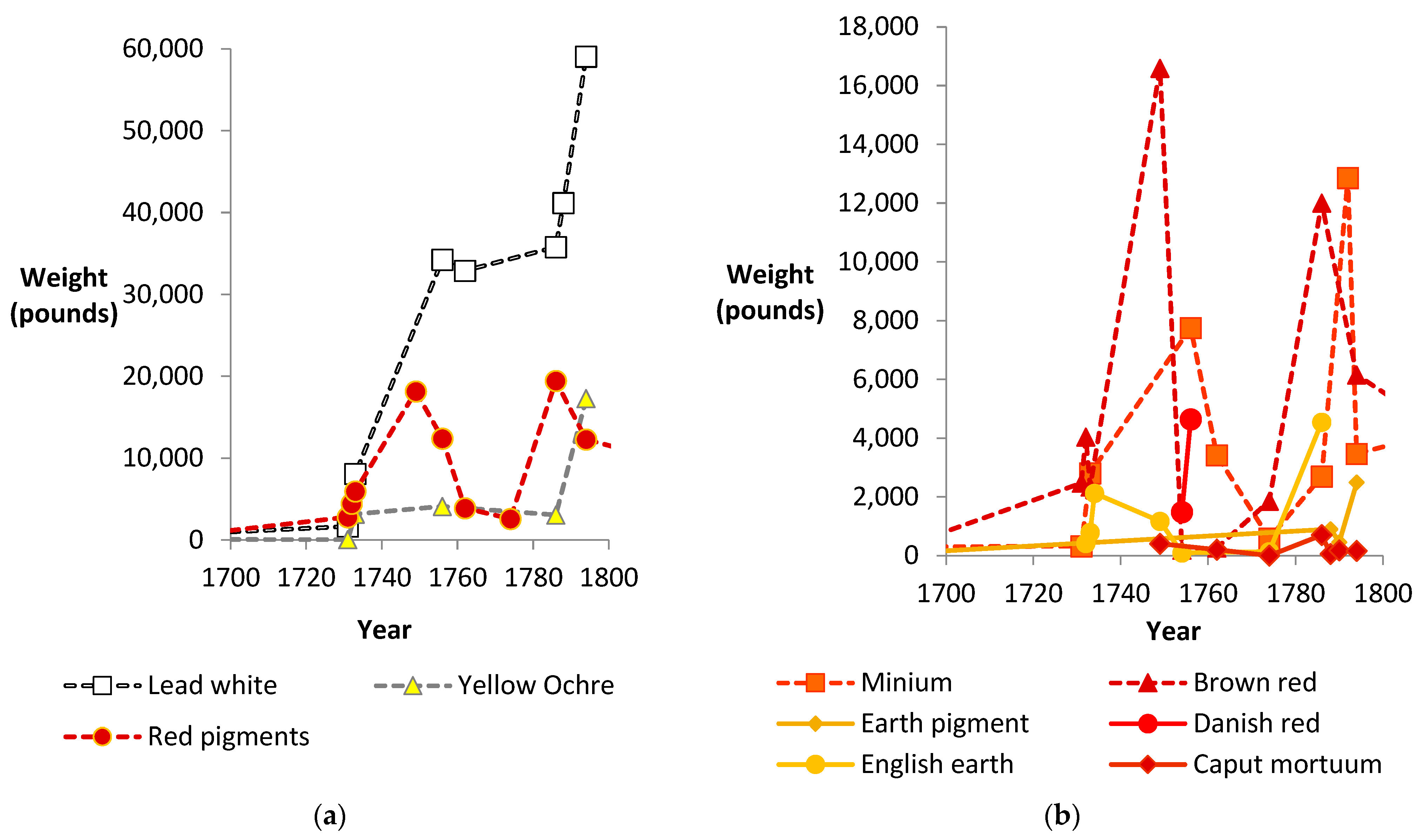
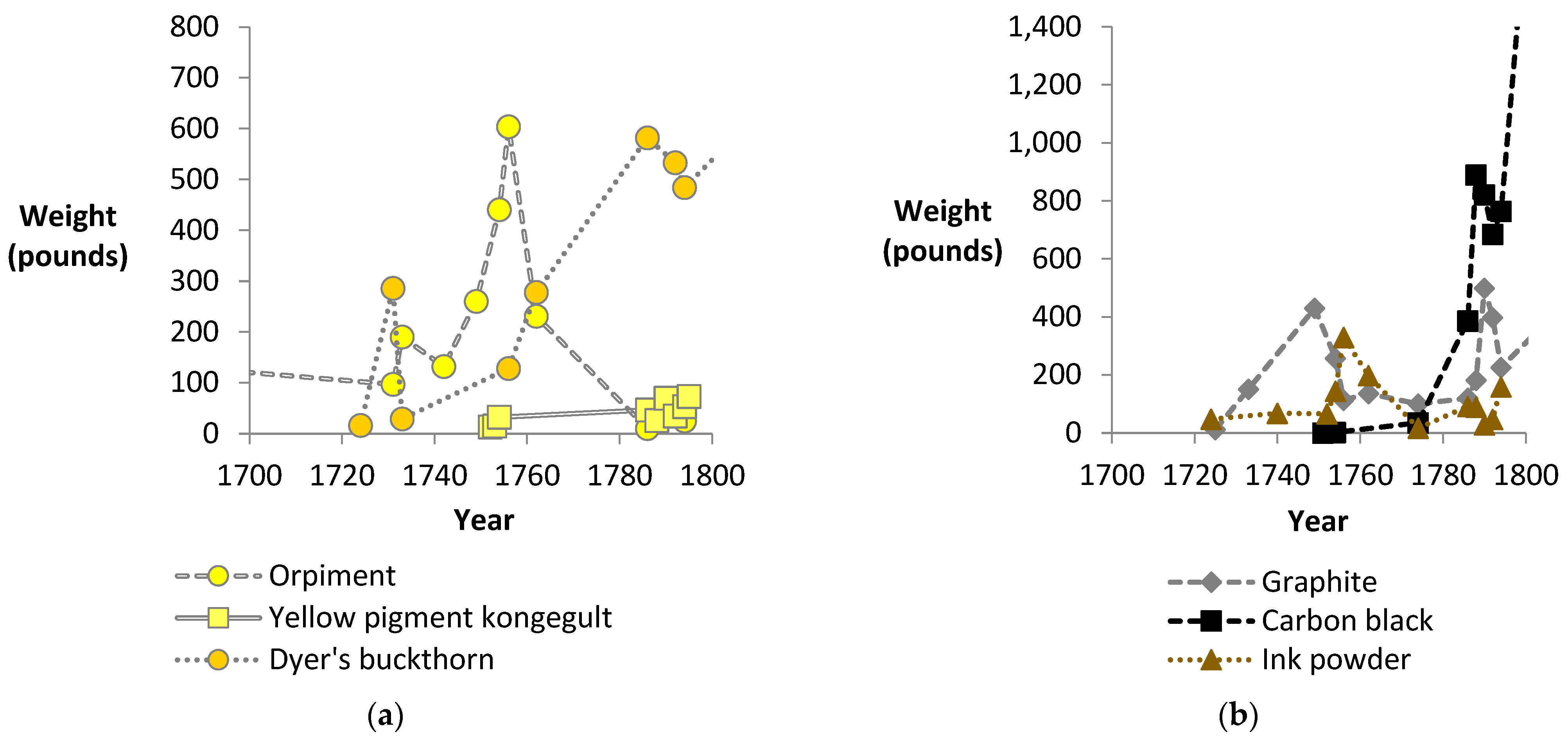





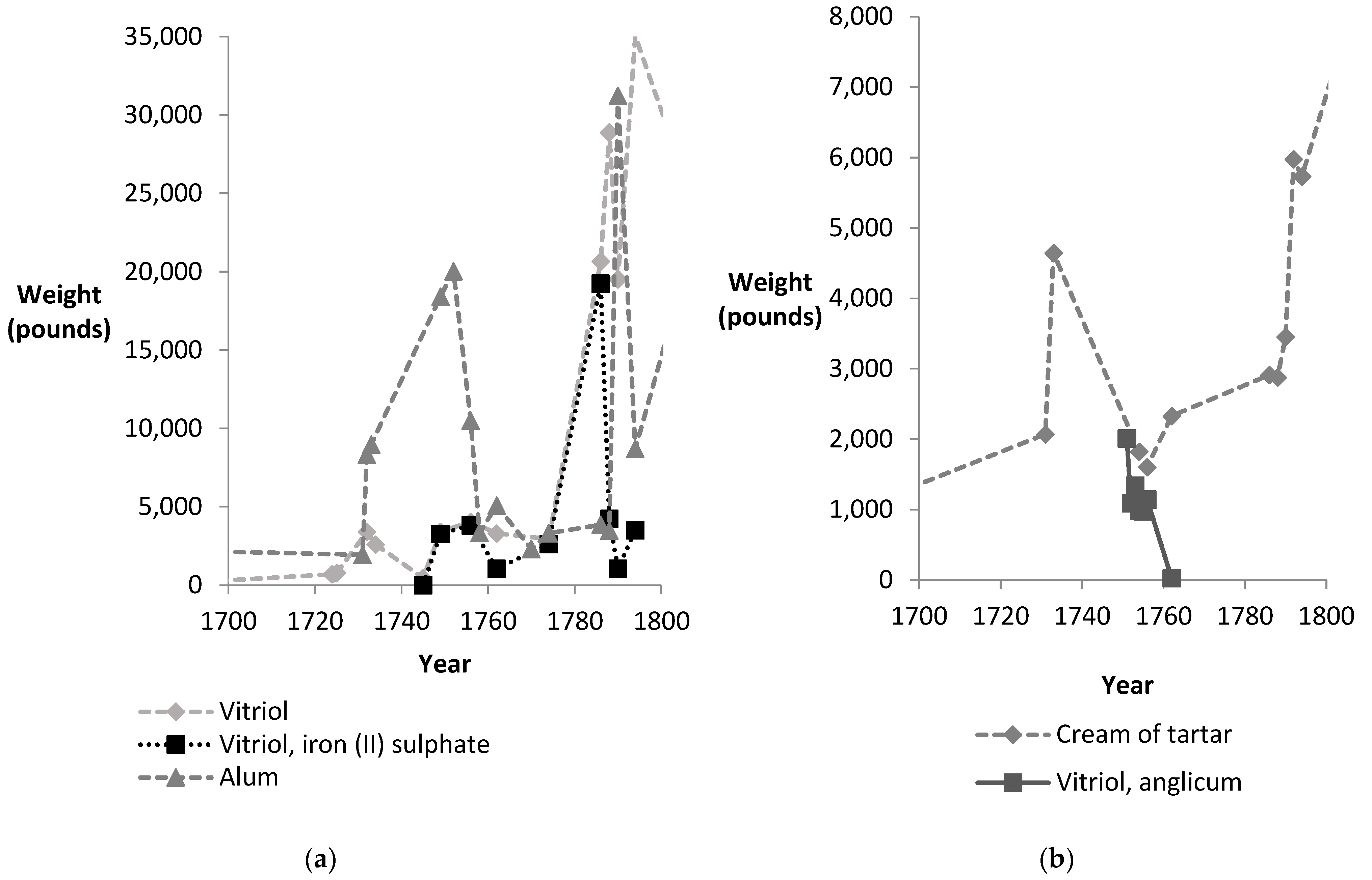
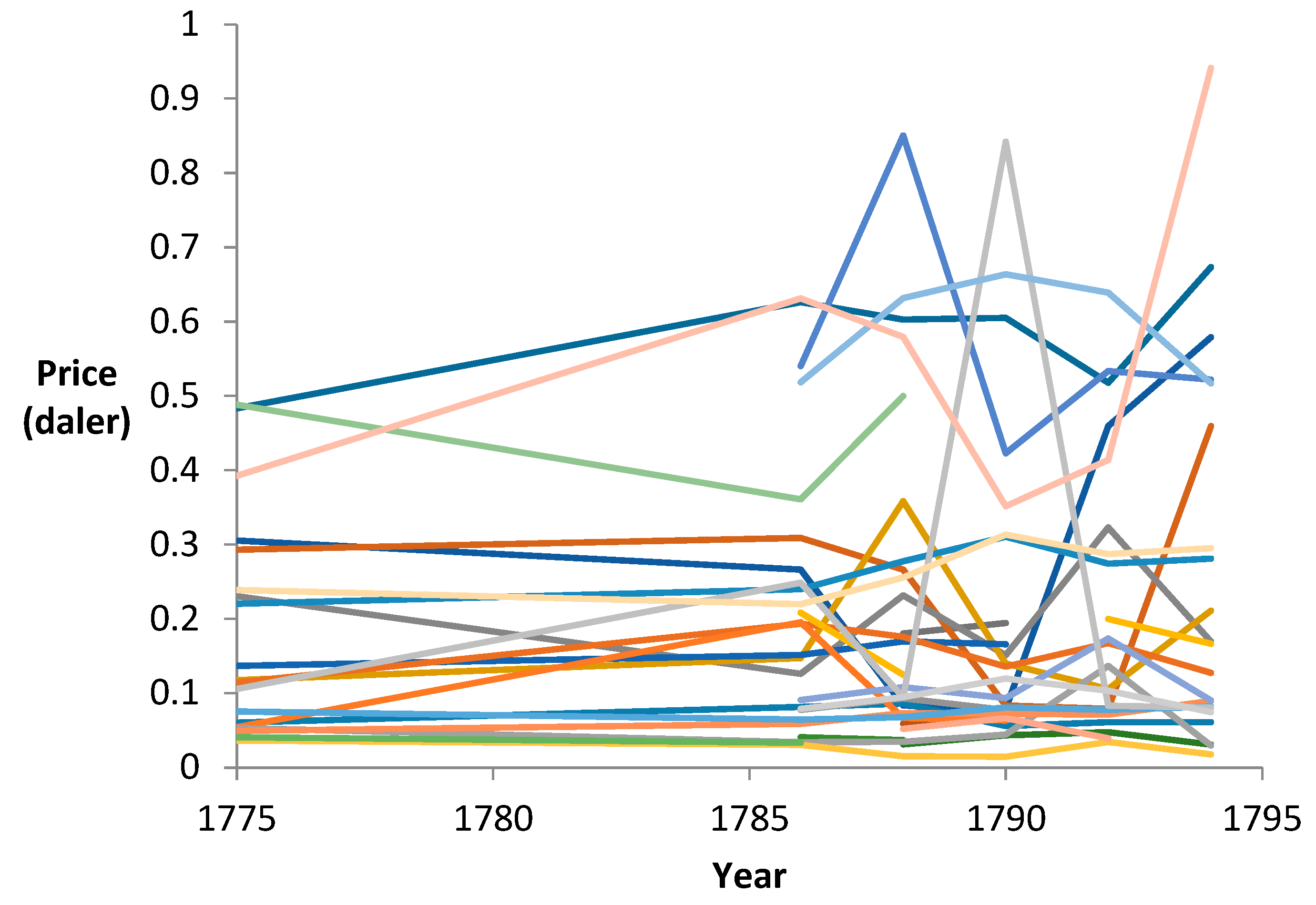

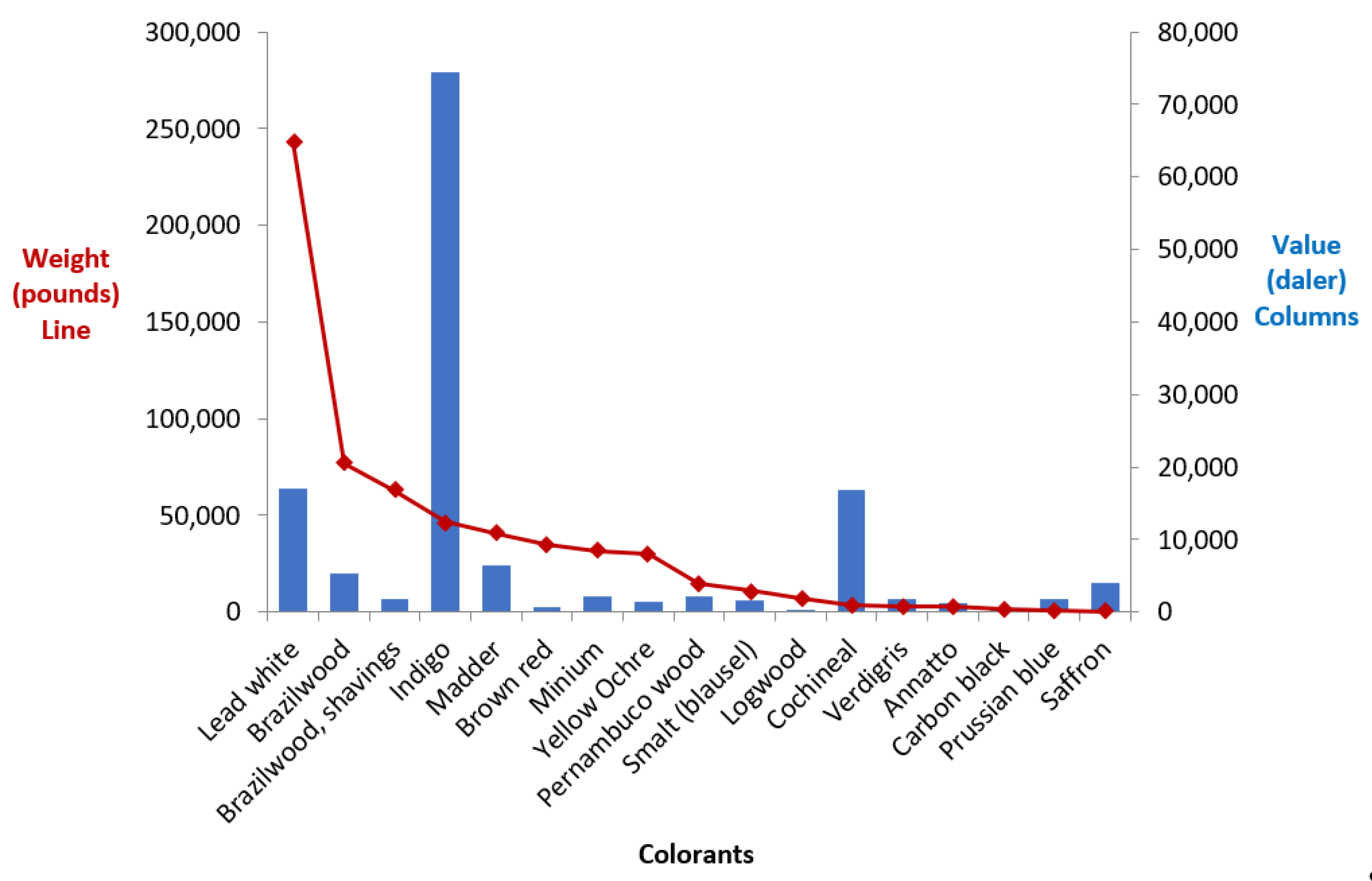











| Town | 1686 | 1731 | 1733 | 1754 | 1756 | 1762 | 1774 | 1786 | 1788 | 1790 | 1792 | 1794 |
|---|---|---|---|---|---|---|---|---|---|---|---|---|
| Bergen | ||||||||||||
| Christiania | ||||||||||||
| Drammen | ||||||||||||
| Trondheim |
| Weight (pounds) | Weight (%) | Color Yield per unit | Weight * Color Yield per unit (pounds) | Weight*Color Yield per unit (%) | Price (daler) | Dye Cost (daler/pound) | Dye Cost Norway (£/ton) | Dye Cost England [52] (£/ton) | |
|---|---|---|---|---|---|---|---|---|---|
| A | B | A*B | C | D=C/B | D | ||||
| Indigo | 68,762 | 27 | 17.8 | 1,223,964 | 67 | 1.60 | 0.09 | 44.9 | 40.3 |
| Cochineal | 4,242 | 2 | 14.5 | 61,509 | 3 | 4.67 | 0.32 | 161.0 | 115.3 |
| Annatto | 4,637 | 2 | 9.2 | 42,660 | 2 | 0.38 | 0.04 | 20.7 | 15.7 |
| Logwood | 13,294 | 5 | 3.9 | 51,847 | 3 | 0.04 | 0.01 | 5.1 | 1.9 |
| Brazilwood | 102,549 | 40 | 3.0 | 307,647 | 17 | 0.07 | 0.02 | 11.7 | 6.8 |
| Madder | 59,920 | 24 | 2.3 | 137,816 | 8 | 0.16 | 0.07 | 34.8 | 32.5 |
Publisher’s Note: MDPI stays neutral with regard to jurisdictional claims in published maps and institutional affiliations. |
© 2022 by the author. Licensee MDPI, Basel, Switzerland. This article is an open access article distributed under the terms and conditions of the Creative Commons Attribution (CC BY) license (https://creativecommons.org/licenses/by/4.0/).
Share and Cite
Knudtzon, M.A. Increased Imports of Colorants and Constituent Components during the 18th Century Reflects the Start of the Consumer Society in Norway. Heritage 2022, 5, 3705-3736. https://doi.org/10.3390/heritage5040193
Knudtzon MA. Increased Imports of Colorants and Constituent Components during the 18th Century Reflects the Start of the Consumer Society in Norway. Heritage. 2022; 5(4):3705-3736. https://doi.org/10.3390/heritage5040193
Chicago/Turabian StyleKnudtzon, Margaret Aasness. 2022. "Increased Imports of Colorants and Constituent Components during the 18th Century Reflects the Start of the Consumer Society in Norway" Heritage 5, no. 4: 3705-3736. https://doi.org/10.3390/heritage5040193
APA StyleKnudtzon, M. A. (2022). Increased Imports of Colorants and Constituent Components during the 18th Century Reflects the Start of the Consumer Society in Norway. Heritage, 5(4), 3705-3736. https://doi.org/10.3390/heritage5040193







